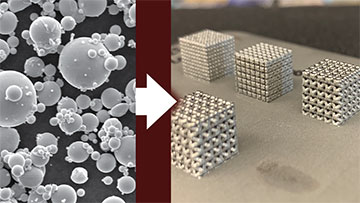
Left: an electron micrograph of nickel-titanium powder. Right: the researchers can use the powder to fabricate 3D-printed parts, such as nickel-titanium lattices. [Image: Texas A&M Engineering]
Thanks to its superelasticity and shape-memory effect, the metal alloy nickel titanium (NiTi) has been a popular ingredient for biomedical devices, actuators and seismic damping systems. However, using NiTi to create complex shapes has been difficult because of the alloy’s toughness and strain hardening. Achieving those shapes via 3D-printing techniques such as laser powder-bed fusion could offer design freedom, but 3D printing often causes NiTi to lose its superelasticity.
Now researchers in the United States have developed a framework for the laser powder-bed fusion method and successfully applied it to printed NiTi parts that exhibit nearly double the superelasticity previously reported for 3D-printed NiTi (Acta Mater., doi: 10.1016/j.actamat.2022.117781).
“This study can serve as a guide on how to print nickel-titanium shape-memory alloys with desired mechanical and functional characteristics,” Lei Xue, first author of the study and a former graduate student at Texas A&M University, USA, said in a press release. “If we can tailor the crystallographic texture and microstructure, there are far more applications these shape-memory alloys can be used in.”
Complex geometry vs. superelasticity
Laser powder-bed fusion has already been widely explored as a potential additive-manufacturing pathway toward complicated geometries using NiTi. In this method, similar to polymer 3D-printing, a laser melts NiTi powder layer by layer, enabling a user to create a desired structure.
Despite its promise, however, using laser powder-bed fusion with NiTi often creates defects in the final product. For example, a sudden temperature increase during melting can trap vapor, generating pores in the product that can lead to cracks, as well as chemical composition change. Fast cooling can lead to warping or delamination. And, most important, all these defects can cause the NiTi to lose its superelasticity as a result.
To help create complex geometries using laser powder-bed fusion while evading defects, the researchers developed an optimization framework for fusion parameters. Using a simple analytical model, the framework—which can be used for alloys other than NiTi—predicts dimensions of the melting pool during the fusion process as a function of material properties and processing parameters such as laser power and scan speed.
Superelasticity record
In their new work, the researchers have applied the framework to manufacture NiTi components. They chose powder with a Ni:Ti atomic ratio close to 50:50, which they determined has a better chance of retaining superelasticity compared with the Ti-rich NiTi powder that is more commonly used in laser powder-bed fusion.
Using the new framework in conjunction with a reduction in the oxygen level in the printing chamber, the researchers created NiTi parts that consistently exhibited superelasticity of 6% in room temperature without any post-fabrication treatment. This result nearly doubles the highest superelasticity that has been reported for the NiTi parts created using an additive-manufacturing technique, according to the researchers, “owing to the selection of optimal process parameters using the same process optimization framework for eliminating defects, controlling crystallographic texture and forming Ni-rich nanoprecipitates.”
Being able to produce 3D-printed superelastic materials will reduce manufacturing cost and time, according to the press release. In the future, the researchers hope the printed NiTi alloys will be used more frequently in biomedical and aerospace applications.
